Các kiểu căn Jacobson của các đại số đường đi Leavitt với hệ số trong nửa vành có đơn vị giao hoán
Trong bài viết này, chúng tôi tính J căn và s J căn của đại số đường đi Leavitt với hệ số
trên một nửa vành có đơn vị giao hoán của một số dạng đồ thị hữu hạn. Trong trường hợp đặc
biệt, chúng tôi tính J căn vàsJ căn của đại số đường đi Leavitt với hệ số trên một trường của
lớp các đồ thị không chu trình, lớp các đồ thị không có lối rẽ và cho các ví dụ áp dụng.

Trang 1
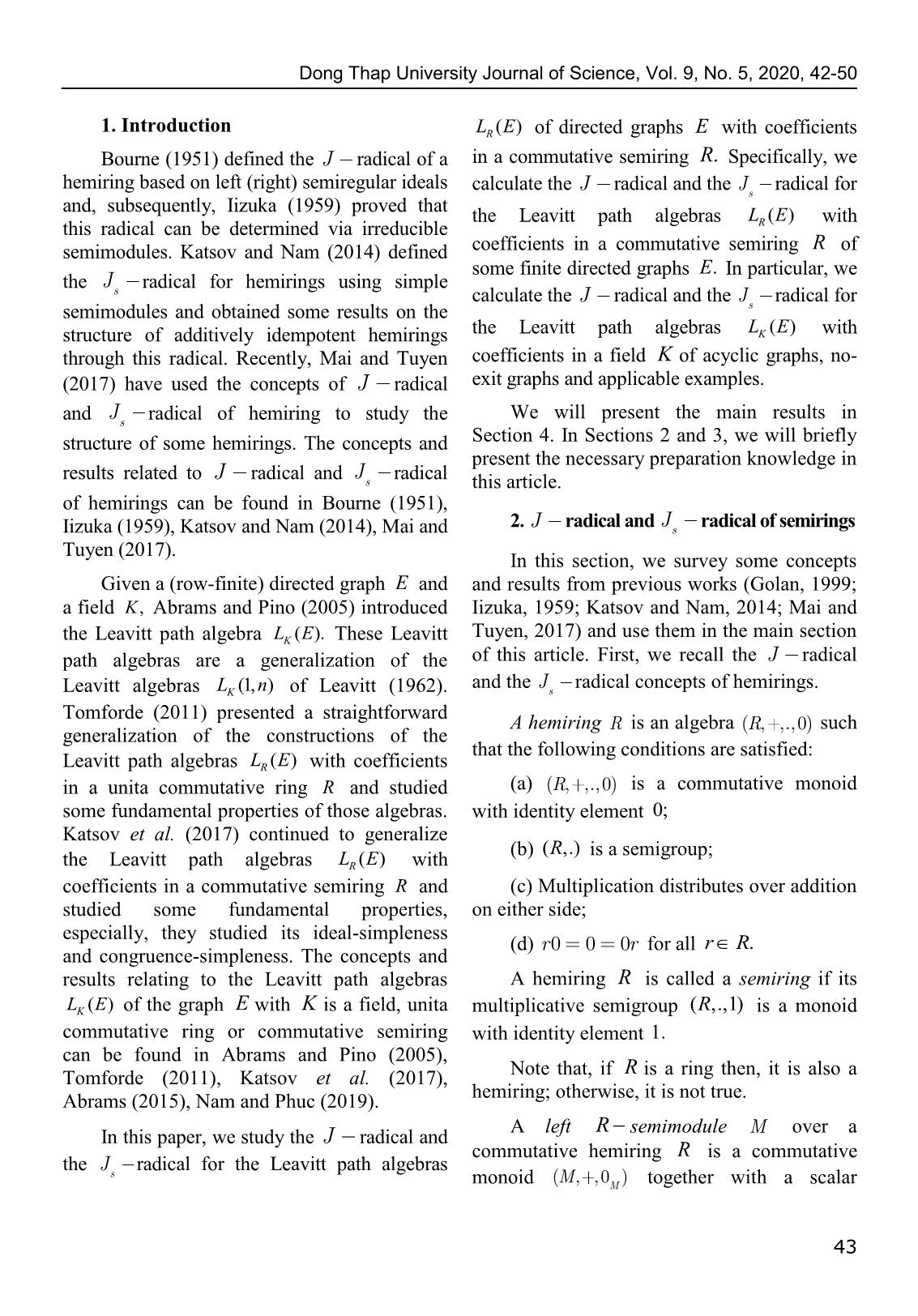
Trang 2
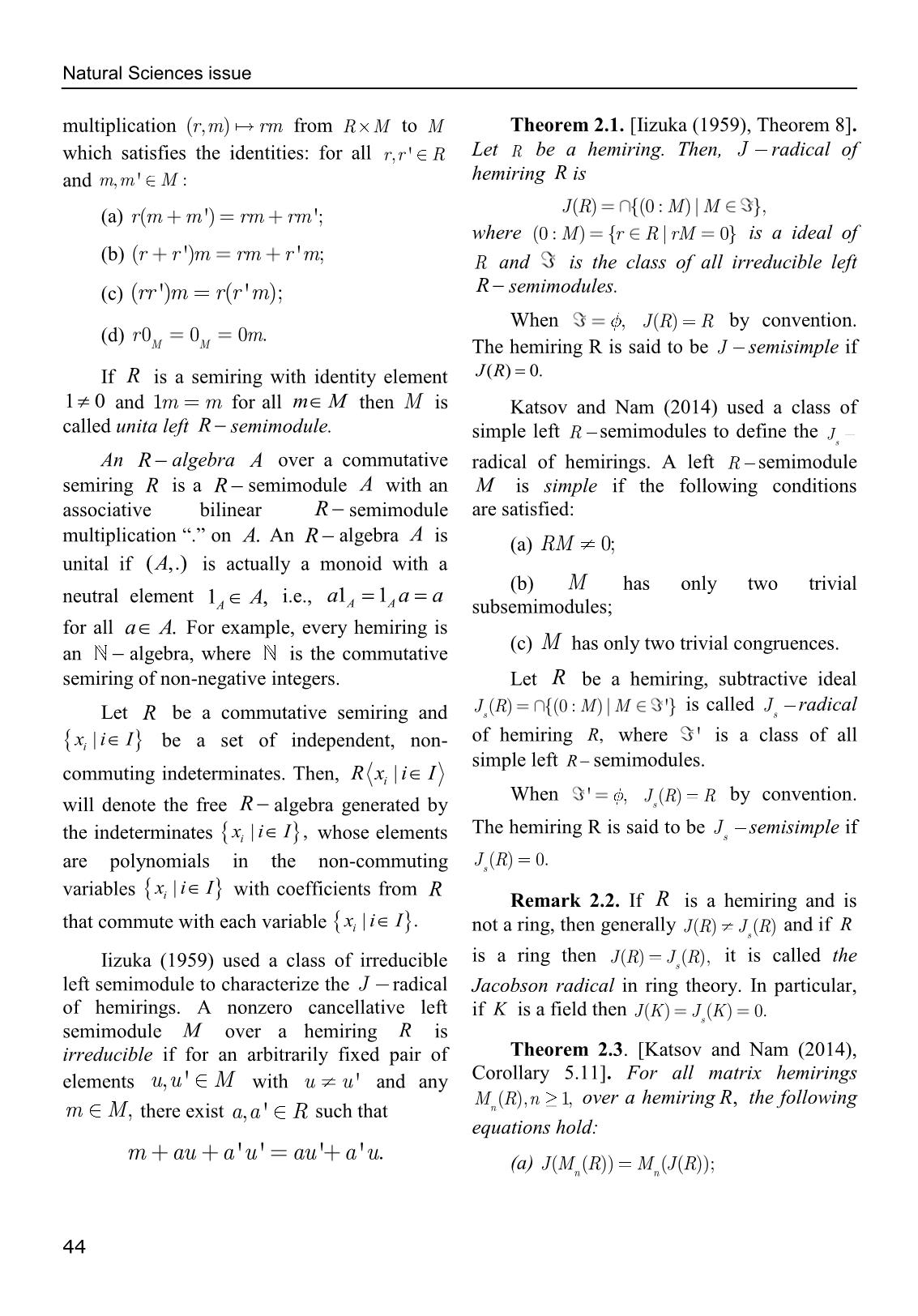
Trang 3
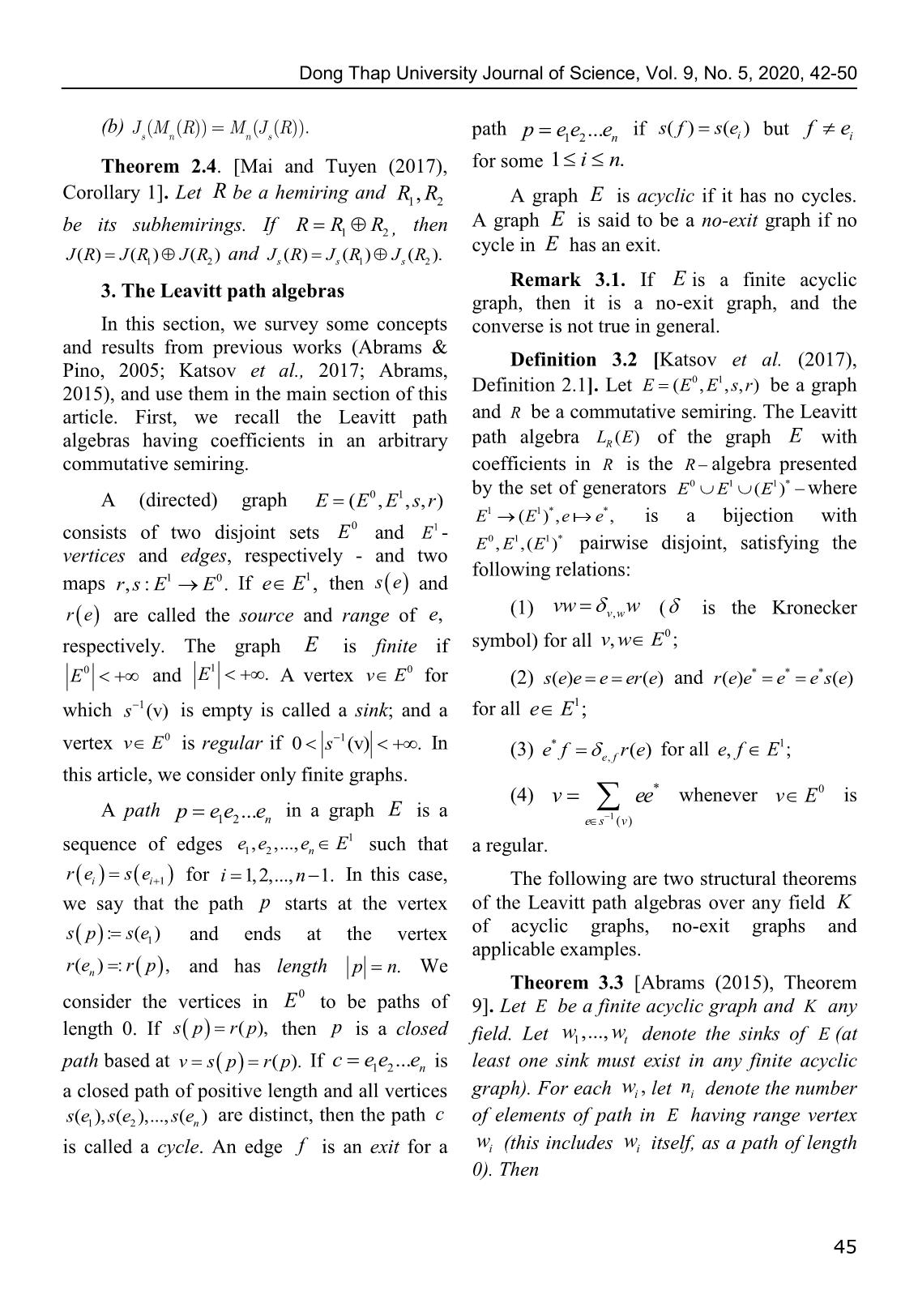
Trang 4
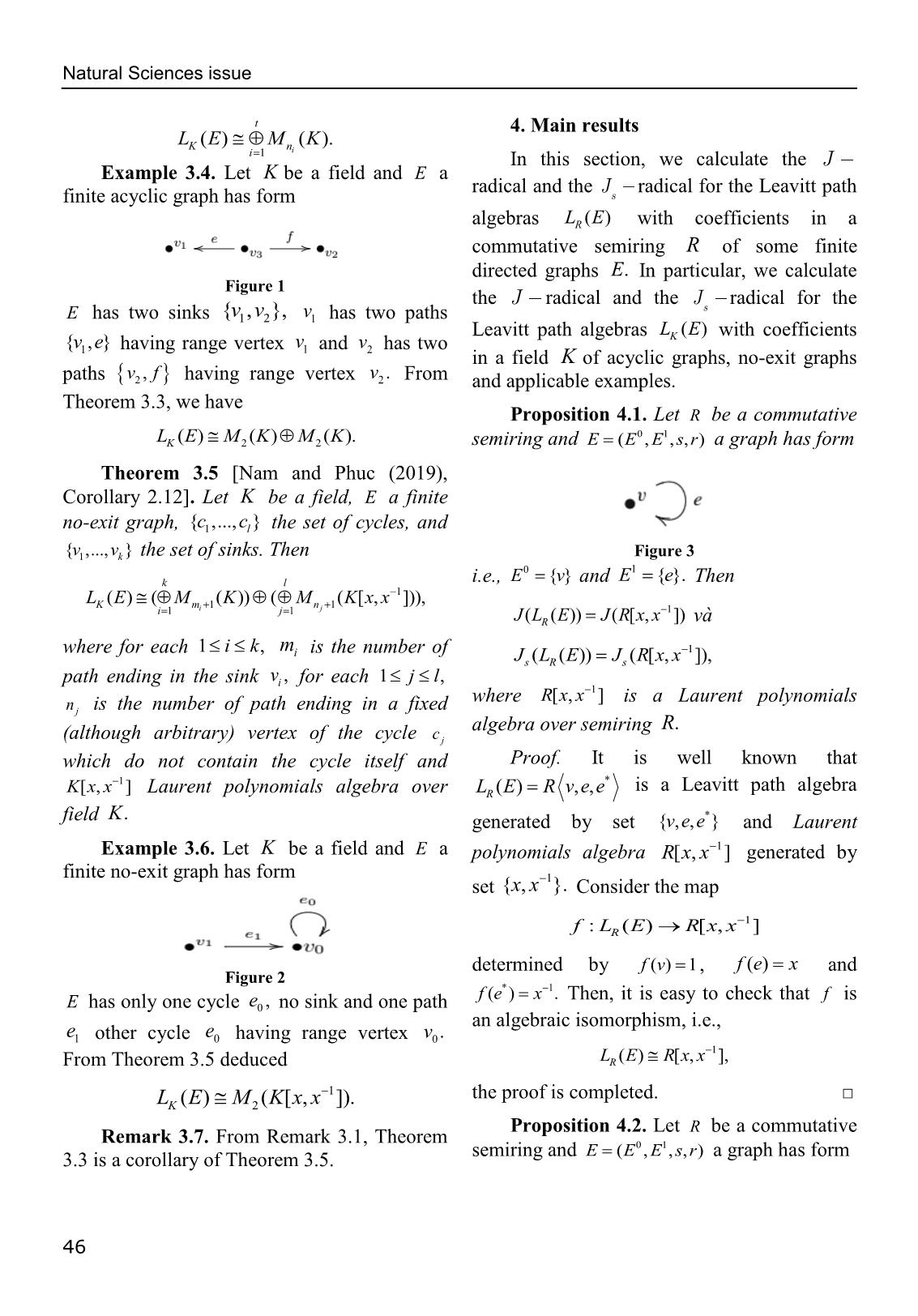
Trang 5
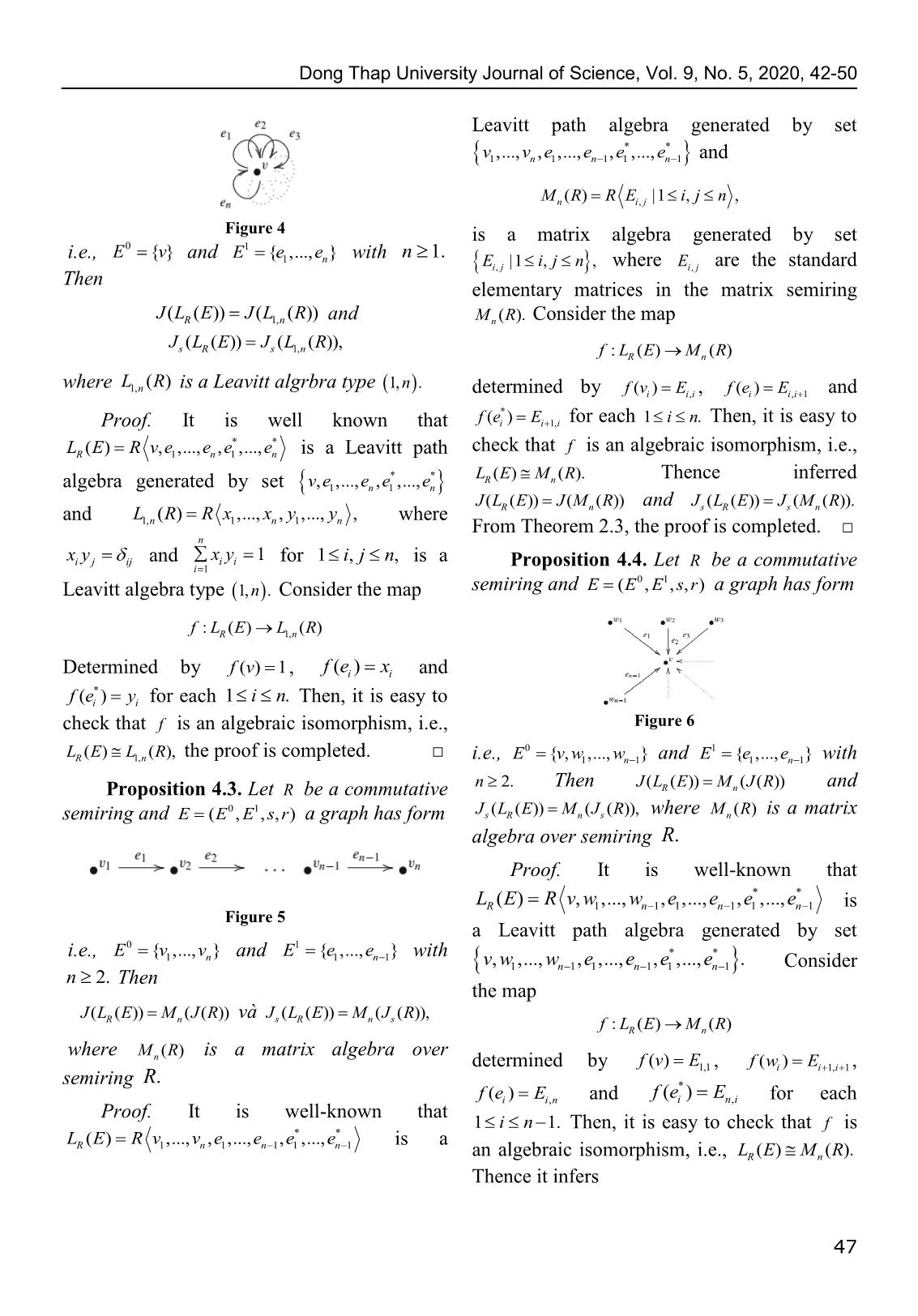
Trang 6
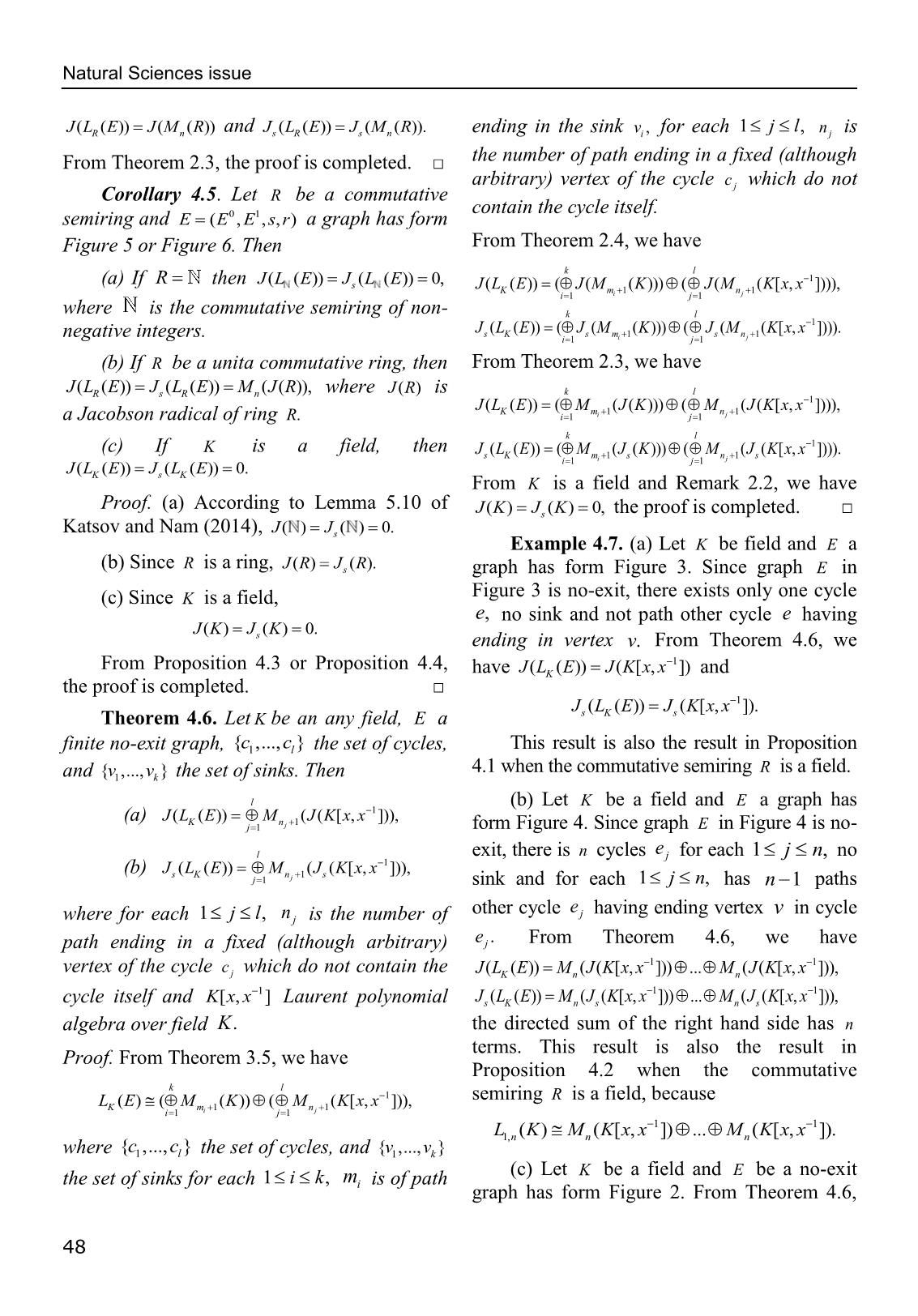
Trang 7
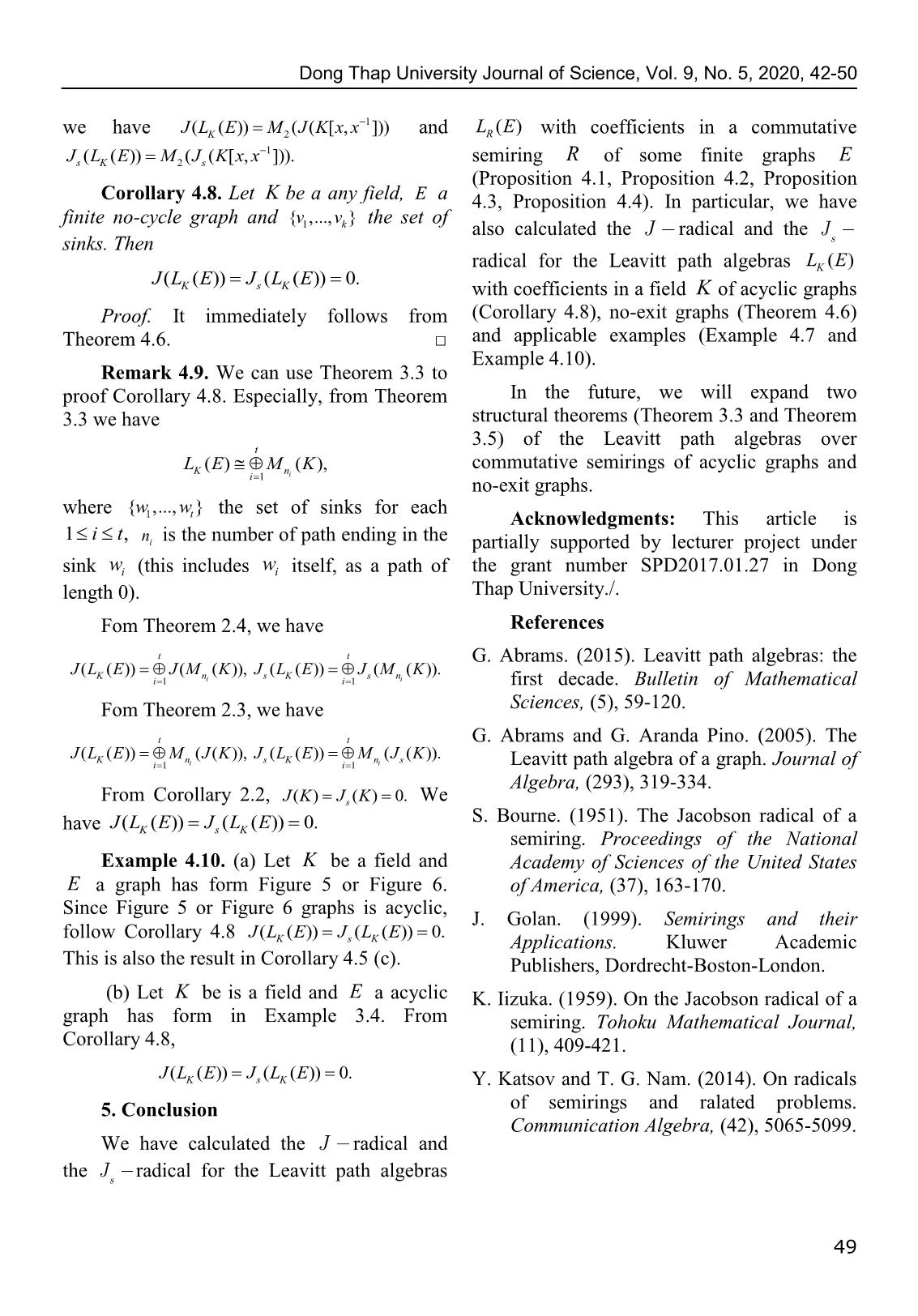
Trang 8
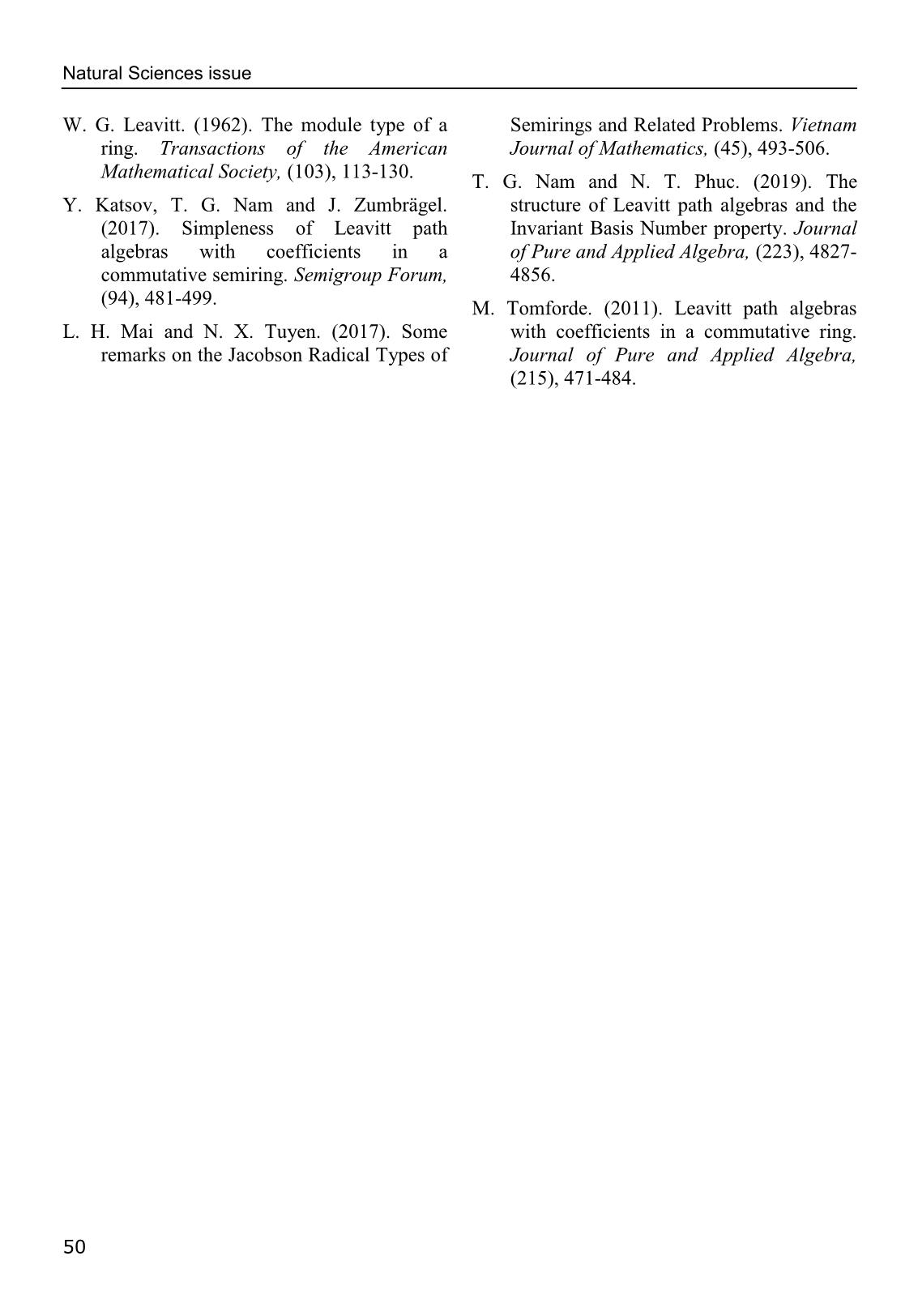
Trang 9
Bạn đang xem tài liệu "Các kiểu căn Jacobson của các đại số đường đi Leavitt với hệ số trong nửa vành có đơn vị giao hoán", để tải tài liệu gốc về máy hãy click vào nút Download ở trên
Tóm tắt nội dung tài liệu: Các kiểu căn Jacobson của các đại số đường đi Leavitt với hệ số trong nửa vành có đơn vị giao hoán
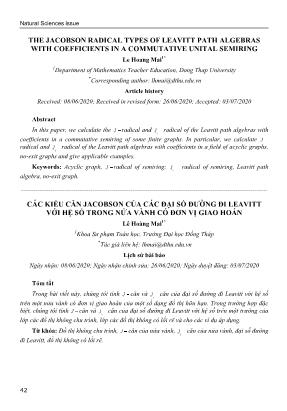
ing is
irreducible if for an arbitrarily fixed pair of Theorem 2.3. [Katsov and Nam (2014),
elements u,' u M with uu' and any Corollary 5.11]. For all matrix hemirings
M( R ), n 1, over a hemiring R, the following
mM, there exist a,' a R such that n
equations hold:
m au a''''. u au a u
(a) JMRMJR(nn ( )) ( ( ));
44
Dong Thap University Journal of Science, Vol. 9, No. 5, 2020, 42-50
(b) JMRMJR( ( )) ( ( )). path if s()() f s e but fe
s n n s i i
Theorem 2.4. [Mai and Tuyen (2017), for some 1. in
Corollary 1]. Let R be a hemiring and RR12, A graph is acyclic if it has no cycles.
A graph is said to be a no-exit graph if no
be its subhemirings. If RRR 12, then
cycle in has an exit.
JRJRJR()()() 12 and JRJRJRs( ) s (12 ) s ( ).
Remark 3.1. If E is a finite acyclic
3. The Leavitt path algebras
graph, then it is a no-exit graph, and the
In this section, we survey some concepts converse is not true in general.
and results from previous works (Abrams &
Definition 3.2 [Katsov et al. (2017),
Pino, 2005; Katsov et al., 2017; Abrams, 01
2015), and use them in the main section of this Definition 2.1]. Let E (,,,) E E s r be a graph
article. First, we recall the Leavitt path and R be a commutative semiring. The Leavitt
algebras having coefficients in an arbitrary path algebra LR ()E of the graph with
commutative semiring. coefficients in is the R algebra presented
by the set of generators E0 EE1 ()1* where
A (directed) graph E (,,,) E01 E s r
E1 (),, E 1* e e * is a bijection with
consists of two disjoint sets E0 and E1 -
EEE0,,() 1 1 * pairwise disjoint, satisfying the
vertices and edges, respectively - and two
following relations:
maps r,:. s E10 E If eE 1, then se and
vw w
re are called the source and range of e, (1) vw, ( is the Kronecker
symbol) for all v, w E0 ;
respectively. The graph E is finite if
E0 and E1 . A vertex vE 0 for ***
(2) s()() e e e er e and r()() e e e e s e
1
which s 1 (v) is empty is called a sink; and a for all eE ;
1
vertex is regular if 0 s (v) . In (3) e* f r() e for all e, f E1;
ef,
this article, we consider only finite graphs.
(4) v ee* whenever vE 0 is
A path in a graph E is a
p e12 e... en e s 1 () v
1
sequence of edges e12, e ,..., en E such that a regular.
r eii s e 1 for in 1,2,..., 1. In this case, The following are two structural theorems
we say that the path p starts at the vertex of the Leavitt path algebras over any field K
s p :() s e and ends at the vertex of acyclic graphs, no-exit graphs and
1 applicable examples.
r():, en r p and has length pn . We
Theorem 3.3 [Abrams (2015), Theorem
0
consider the vertices in E to be paths of 9]. Let E be a finite acyclic graph and K any
length 0. If s p r( p ), then is a closed
field. Let ww1,..., t denote the sinks of E (at
path based at v s p r( p ). If c e12 e... en is least one sink must exist in any finite acyclic
a closed path of positive length and all vertices graph). For each wi , let ni denote the number
s( e12 ), s ( e ),..., s ( en ) are distinct, then the path c of elements of path in having range vertex
is called a cycle. An edge f is an exit for a wi (this includes itself, as a path of length
0). Then
45
Natural Sciences issue
t 4. Main results
LEMK( ) ( ).
Kni
i 1 In this section, we calculate the J
Example 3.4. Let K be a field and E a
radical and the J radical for the Leavitt path
finite acyclic graph has form s
LE()
algebras R with coefficients in a
commutative semiring R of some finite
directed graphs E. In particular, we calculate
Figure 1
the radical and the radical for the
has two sinks {vv12 , }, v1 has two paths
Leavitt path algebras LE()with coefficients
{,}ve having range vertex v and v has two K
1 1 2 in a field K of acyclic graphs, no-exit graphs
vf, v .
paths 2 having range vertex 2 From and applicable examples.
Theorem 3.3, we have
Proposition 4.1. Let R be a commutative
01
LEMKMKK ( )22 ( ) ( ). semiring and E (,,,) E E s r a graph has form
Theorem 3.5 [Nam and Phuc (2019),
Corollary 2.12]. Let be a field, a finite
no-exit graph, {cc ,..., } the set of cycles, and
1 l
{vv1 ,...,k } the set of sinks. Then Figure 3
0 1
kl i.e., E {}v and E {e }. Then
1
LK()( E M m 11 ())( K M n ([, K x x ])),
ij 11ij 1
J( LR ( E )) J ( R [ x , x ]) và
m 1
where for each 1, ik i is the number of J( L ( E )) J ( R [ x , x ]),
s R s
path ending in the sink vi , for each 1, jl
where R[,] x x 1 is a Laurent polynomials
n j is the number of path ending in a fixed
algebra over semiring R.
(although arbitrary) vertex of the cycle c j
which do not contain the cycle itself and Proof. It is well known that
1 *
K[,] x x Laurent polynomials algebra over LR (),, E R v e e is a Leavitt path algebra
field K. generated by set {,,}v e e* and Laurent
Example 3.6. Let be a field and a polynomials algebra R[,] x x 1 generated by
finite no-exit graph has form
set {xx , 1 }. Consider the map
f:()[,] L E R x x 1
R
determined by fv( ) 1, f() e x and
Figure 2
f(). e*1 x Then, it is easy to check that f is
has only one cycle e0 , no sink and one path
an algebraic isomorphism, i.e.,
e1 other cycle e0 having range vertex v0 .
L( E ) R [ x , x 1 ],
From Theorem 3.5 deduced R
L( E ) M ( K [ x , x 1 ]). the proof is completed. □
K 2
Proposition 4.2. Let be a commutative
Remark 3.7. From Remark 3.1, Theorem
3.3 is a corollary of Theorem 3.5. semiring and a graph has form
46
Dong Thap University Journal of Science, Vol. 9, No. 5, 2020, 42-50
Leavitt path algebra generated by set
v,..., v , e ,..., e , e** ,..., e
1n 1 n 1 1 n 1 and
M( R ) R E |1 i , j n ,
n i, j
Figure 4 is a matrix algebra generated by set
E0 {}v E1 {ee ,..., } n 1.
i.e., and 1 n with E|1 i , j n , where E are the standard
ij, ij,
Then
elementary matrices in the matrix semiring
JLEJLR(Rn ( )) (1, ( )) and MRn ( ). Consider the map
JLEJLRs( R ( )) s (1, n ( )),
f:()() LRn E M R
where LR1,n () is a Leavitt algrbra type 1,n .
determined by f() vi E i, i , f() ei E i,1 i and
*
Proof. It is well known that f() ei E i 1, i for each 1. in Then, it is easy to
**
LR( E ) R v , e11 ,..., e n , e ,..., e n is a Leavitt path check that is an algebraic isomorphism, i.e.,
** LEMRRn( ) ( ). Thence inferred
algebra generated by set v, e11 ,..., enn , e ,..., e
JLEJMR( ( )) ( ( )) and JLEJMR( ( )) ( ( )).
and L( R ) R x ,..., x , y ,..., y , where Rn s R s n
1,n 1 n 1 n From Theorem 2.3, the proof is completed. □
n
xyi j ij and xyii 1 for 1 i , j n , is a
i 1 Proposition 4.4. Let be a commutative
Leavitt algebra type Consider the map semiring and a graph has form
f:()() LRn E L1, R
Determined by fv( ) 1, f() eii x and
f() e* y 1. in
ii for each Then, it is easy to
check that f is an algebraic isomorphism, i.e., Figure 6
0
LELRRn( ) 1, ( ), the proof is completed. □ i.e., E { v , w ,..., w } and with
1 n 1
n 2. Then and
Proposition 4.3. Let R be a commutative
01 JLEMJR( ( )) ( ( )), where is a matrix
semiring and E (,,,) E E s r a graph has form s R n s
algebra over semiring
Proof. It is well-known that
**
LR( E ) R v , w1 ,..., w n 1 , e 1 ,..., e n 1 , e 1 ,..., e n 1 is
Figure 5
a Leavitt path algebra generated by set
0 1
i.e., E {vv1 ,...,n } and E {ee1 ,...,n 1 } with **
v, w1 ,..., wn 1 , e 1 ,..., e n 1 , e 1 ,..., e n 1 . Consider
n 2. Then
the map
JLEMJR(Rn ( )) ( ( )) và JLEMJRs( R ( )) n ( s ( )),
f:()() LRn E M R
where MRn () is a matrix algebra over
determined by f() v E1,1 , f() wi E i 1, i 1 ,
semiring R. *
f() ei E i, n and f() ei E n, i for each
Proof. It is well-known that
1 in 1. Then, it is easy to check that is
**
LR( E ) R v1 ,..., v n , e 1 ,..., e n 1 , e 1 ,..., e n 1 is a
an algebraic isomorphism, i.e., LEMRRn( ) ( ).
Thence it infers
47
Natural Sciences issue
JLEJMR(Rn ( )) ( ( )) and JLEJMRs( R ( )) s ( n ( )). ending in the sink vi , for each 1, jl is
From Theorem 2.3, the proof is completed. □ the number of path ending in a fixed (although
arbitrary) vertex of the cycle which do not
Corollary 4.5. Let R be a commutative
contain the cycle itself.
semiring and E (,,,) E01 E s r a graph has form
Figure 5 or Figure 6. Then From Theorem 2.4, we have
kl
(a) If R then JLEJLE( ( )) ( ( )) 0, 1
s JLE(K ( )) ( JM ( m 11 ( K ))) ( JM ( n ( Kxx [ , ]))),
ij 11ij
where is the commutative semiring of non- kl
1
JLEs( K ( )) ( JM s ( m 11 ( K ))) ( JMKxx s ( n ( [ , ]))).
negative integers. ij 11ij
(b) If R be a unita commutative ring, then From Theorem 2.3, we have
JLEJLEMJR(R ( )) s ( R ( )) n ( ( )), where JR() is kl
1
JLE(K ( )) ( M m 11 ( JK ( ))) ( M n ( JKxx ( [ , ]))),
a Jacobson radical of ring R. ij 11ij
kl
1
(c) If K is a field, then JLEs( K ( )) ( M m 11 ( JK s ( ))) ( MJKxx n ( s ( [ , ]))).
ij 11ij
JLEJLE(K ( )) s ( K ( )) 0.
From K is a field and Remark 2.2, we have
Proof. (a) According to Lemma 5.10 of
JKJK( ) s ( ) 0, the proof is completed. □
Katsov and Nam (2014), JJ( ) s ( ) 0.
Example 4.7. (a) Let be field and a
(b) Since R is a ring, JRJR( ) s ( ). graph has form Figure 3. Since graph in
(c) Since K is a field, Figure 3 is no-exit, there exists only one cycle
e, no sink and not path other cycle e having
JKJK( ) ( ) 0.
s ending in vertex v. From Theorem 4.6, we
From Proposition 4.3 or Proposition 4.4, 1
have J( LK ( E )) J ( K [ x , x ]) and
the proof is completed. □
J( L ( E )) J ( K [ x , x 1 ]).
Theorem 4.6. Let K be an any field, E a s K s
finite no-exit graph, {cc1 ,...,l } the set of cycles, This result is also the result in Proposition
4.1 when the commutative semiring R is a field.
and {vv1 ,...,k } the set of sinks. Then
l (b) Let be a field and a graph has
1
(a) J( LKn ( E )) M 1 ( J ( K [ x , x ])),
j 1 j form Figure 4. Since graph in Figure 4 is no-
l exit, there is n cycles e j for each 1, jn no
1
(b) Js( L K ( E )) M n 1 ( J s ( K [ x , x ])),
j 1 j sink and for each 1, jn has n 1 paths
other cycle e j having ending vertex v in cycle
where for each 1, jl n j is the number of
path ending in a fixed (although arbitrary) e j . From Theorem 4.6, we have
11
vertex of the cycle c j which do not contain the JLE(K ( )) MJKxx n ( ( [ , ])) ... MJKxx n ( ( [ , ])),
1 11
cycle itself and K[,] x x Laurent polynomial JLEs( K ( )) MJKxx n ( s ( [ , ])) ... MJKxx n ( s ( [ , ])),
algebra over field K. the directed sum of the right hand side has n
terms. This result is also the result in
Proof. From Theorem 3.5, we have
Proposition 4.2 when the commutative
kl
1 semiring is a field, because
LK()( E M m 11 ())( K M n ([, K x x ])),
ij 11ij
11
L1,n( K ) M n ( K [ x , x ]) ... M n ( K [ x , x ]).
where the set of cycles, and
the set of sinks for each 1, ik m is of path (c) Let be a field and be a no-exit
i graph has form Figure 2. From Theorem 4.6,
48
Dong Thap University Journal of Science, Vol. 9, No. 5, 2020, 42-50
we have J( L ()) E M (([, J K x x 1 ])) and LE() with coefficients in a commutative
K 2 R
J( L ( E )) M ( J ( K [ x , x 1 ])). semiring R of some finite graphs E
s K2 s
(Proposition 4.1, Proposition 4.2, Proposition
Corollary 4.8. Let K be a any field, E a 4.3, Proposition 4.4). In particular, we have
finite no-cycle graph and {vv ,..., } the set of
1 k also calculated the radical and the
sinks. Then
radical for the Leavitt path algebras LEK ()
JLEJLE( ( )) ( ( )) 0.
K s K with coefficients in a field K of acyclic graphs
Proof. It immediately follows from (Corollary 4.8), no-exit graphs (Theorem 4.6)
Theorem 4.6. □ and applicable examples (Example 4.7 and
Example 4.10).
Remark 4.9. We can use Theorem 3.3 to
proof Corollary 4.8. Especially, from Theorem In the future, we will expand two
3.3 we have structural theorems (Theorem 3.3 and Theorem
3.5) of the Leavitt path algebras over
t
LEMK( ) ( ), commutative semirings of acyclic graphs and
Kni
i 1 no-exit graphs.
where {ww ,..., } the set of sinks for each
1 t Acknowledgments: This article is
1, itn
i is the number of path ending in the partially supported by lecturer project under
sink wi (this includes wi itself, as a path of the grant number SPD2017.01.27 in Dong
length 0). Thap University./.
Fom Theorem 2.4, we have References
t t G. Abrams. (2015). Leavitt path algebras: the
JLEJMK(Kn ( )) ( ( )), JLEJMKs( K ( )) s ( n ( )).
i 1 i i 1 i first decade. Bulletin of Mathematical
Fom Theorem 2.3, we have Sciences, (5), 59-120.
t t G. Abrams and G. Aranda Pino. (2005). The
JLEMJK(Kn ( )) ( ( )), JLEMJKs( K ( )) n ( s ( )).
i 1 i i 1 i Leavitt path algebra of a graph. Journal of
Algebra, (293), 319-334.
From Corollary 2.2, JKJK( ) s ( ) 0. We
have S. Bourne. (1951). The Jacobson radical of a
semiring. Proceedings of the National
Example 4.10. (a) Let be a field and Academy of Sciences of the United States
a graph has form Figure 5 or Figure 6. of America, (37), 163-170.
Since Figure 5 or Figure 6 graphs is acyclic,
J. Golan. (1999). Semirings and their
follow Corollary 4.8 JLEJLE( ( )) ( ( )) 0.
K s K Applications. Kluwer Academic
This is also the result in Corollary 4.5 (c). Publishers, Dordrecht-Boston-London.
(b) Let be is a field and a acyclic K. Iizuka. (1959). On the Jacobson radical of a
graph has form in Example 3.4. From semiring. Tohoku Mathematical Journal,
Corollary 4.8, (11), 409-421.
JLEJLE( ( )) ( ( )) 0.
K s K Y. Katsov and T. G. Nam. (2014). On radicals
5. Conclusion of semirings and ralated problems.
Communication Algebra, (42), 5065-5099.
We have calculated the J radical and
the Js radical for the Leavitt path algebras
49
Natural Sciences issue
W. G. Leavitt. (1962). The module type of a Semirings and Related Problems. Vietnam
ring. Transactions of the American Journal of Mathematics, (45), 493-506.
Mathematical Society, (103), 113-130. T. G. Nam and N. T. Phuc. (2019). The
Y. Katsov, T. G. Nam and J. Zumbrägel. structure of Leavitt path algebras and the
(2017). Simpleness of Leavitt path Invariant Basis Number property. Journal
algebras with coefficients in a of Pure and Applied Algebra, (223), 4827-
commutative semiring. Semigroup Forum, 4856.
(94), 481-499. M. Tomforde. (2011). Leavitt path algebras
L. H. Mai and N. X. Tuyen. (2017). Some with coefficients in a commutative ring.
remarks on the Jacobson Radical Types of Journal of Pure and Applied Algebra,
(215), 471-484.
50 File đính kèm:
 cac_kieu_can_jacobson_cua_cac_dai_so_duong_di_leavitt_voi_he.pdf
cac_kieu_can_jacobson_cua_cac_dai_so_duong_di_leavitt_voi_he.pdf

